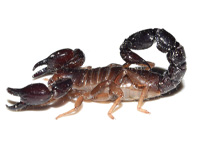Abstract
We describe a new scorpion species in the troglomorphic genus Troglotayosicus Lourenço, 1981 from Colombia. Troglotayosicus meijdeni sp. nov. inhabits the forest leaf litter at Rivera municipality, on the western slope of the Eastern Andes. The male of the new species remains unknown; however, this species can be distinguished from other species in the genus by the female (and juvenile) morphology. The type locality of T. meijdeni sp. nov. represents the northernmost known record for a population of Troglotayosicus, further extending the known limits of distribution of this genus, and shedding more light on the distributional range of this group of scorpions in northwestern South America. With this description, the number of known species of Troglotayosicus is raised to four; three of them are endogean species living in forested areas in the Andean region of Colombia, whereas one is a hypogean species from a cave in Ecuadorian Amazonia.
References
Botero-Trujillo, R. & Francke, O.F. (2009) A new species of troglomorphic leaf litter scorpion from Colombia belonging to the genus Troglotayosicus (Scorpiones: Troglotayosicidae). Texas Memorial Museum Speleological Monographs 7. Studies on the cave and endogean fauna of North America, V, 1–10.
Botero-Trujillo, R., Ochoa, J.A., Tovar, O.A. & Souza, J.E. (2012) A new species in the scorpion genus Troglotayosicus from forest leaf litter in southwestern Colombia (Scorpiones, Troglotayosicidae). Zootaxa, 3506, 63–76.
Cloudsley-Thompson, J.L. (1968) Spiders, scorpions, centipedes, and mites. Pergamon Press, New York, 228 pp.
Loria, S.F. & Prendini, L. (2014) Homology of the lateral eyes of Scorpiones: A six-ocellus model. PLoS ONE, 9 (12), 1–30.
https://doi.org/10.1371/journal.pone.0112913Lourenço, W.R. (1981) Scorpions cavernicoles de l’Équateur: Tityus demangei n. sp. et Ananteris ashmolei n. sp. (Buthidae); Troglotayosicus vachoni n. gen., n. sp. (Chactidae), scorpion troglobie. Bulletin du Muséum national d’Histoire naturelle, Paris, Zoologie (Biologie et Écologie Animale), 3, 635–662.
Lourenço, W.R. (1998) Panbiogeographie, les distributions disjointes et le concept de famille relictuelle chez les scorpions. Biogeographica, 74 (3), 133–144.
McCormick, S.J. & Polis, G.A. (1990) Prey, Predators, and Parasites. In: Polis, G.A. (Ed.), The biology of scorpions. Stanford University Press, Stanford, CA, pp. 145–157.
Ochoa, J.A., Botero-Trujillo, R. & Prendini, L. (2010) On the troglomorphic scorpion Troglotayosicus humiculum (Scorpiones, Troglotayosicidae), with first description of the adults. American Museum Novitates, 3691, 1–19, 12 figs, 1 table.
Polis, G.A. (1980) The effect of cannibalism on the demography and activity of a natural population of desert scorpions. Behavioral Ecology and Sociobiology, 7, 25–35.
https://doi.org/10.1007/BF00302515Prendini, L. (2000) Phylogeny and classification of the superfamily Scorpionoidea Latreille 1802 (Chelicerata, Scorpiones): An exemplar approach. Cladistics, 16, 1–78.
https://doi.org/10.1111/j.1096-0031.2000.tb00348.xPrendini, L. (2004) The systematics of southern African Parabuthus Pocock (Scorpiones, Buthidae): revisions to the taxonomy and key to the species. Journal of Arachnology, 32, 109–186.
https://doi.org/10.1636/H03-17Prendini, L., Francke, O.F. & Vignoli, V. (2009) Troglomorphism, trichobothriotaxy and typhlochactid phylogeny (Scorpiones, Chactoidea): more evidence that troglobitism is not an evolutionary dead-end. Cladistics, 25, 1–26.
Prendini, L. & Wheeler, W.C. (2005) Scorpion higher phylogeny and classification, taxonomic anarchy, and standards for peer review in online publishing. Cladistics, 21, 446–494.
https://doi.org/10.1111/j.1096-0031.2005.00073.xSissom, W.D., Polis, G.A. & Watt, D.D. (1990) Field and laboratory methods. In: Polis, G.A. (Ed.). The biology of scorpions. Stanford University Press, Stanford, CA, pp. 445–461.
Stahnke, H.L. (1970) Scorpion nomenclature and mensuration. Entomological News, 81, 297–316.
Stahnke, H.L. (1972) U.V. light, a useful field tool. BioScience, 22 (10), 604–607.
https://doi.org/10.2307/1296207Vachon, M. (1952) Étude sur les scorpions. Institut Pasteur d’Algérie, Alger, 482 pp.
Vachon, M. (1963) De l’utilité, en systématique, d’une nomenclature des dents des chélicères chez les scorpions. Bulletin du Muséum national de Histoire naturelle Paris, Série 2e, 35 (2), 161–166.
Vachon, M. ("1973" [1974]) Étude des caractères utilisés pour classer les familles et les genres de scorpions (Arachnides). 1. La trichobothriotaxie en arachnologie. Sigles trichobothriaux et types de trichobothriotaxie chez les scorpions. Bulletin du Muséum national d’Histoire Naturelle Paris (3e sér, Zoologie), 140, 857–958.
Vignoli, V. & Prendini, L. (2009) Systematic revision of the troglomorphic North American scorpion family Typhlochactidae (Scorpiones: Chactoidea). Bulletin of the American Museum of Natural History, 326, 1–94.
https://doi.org/10.1206/570.1

